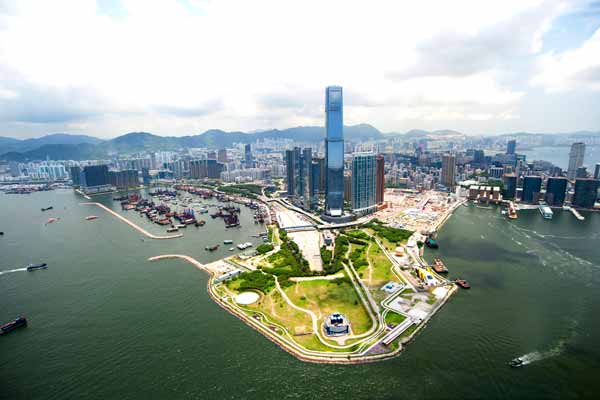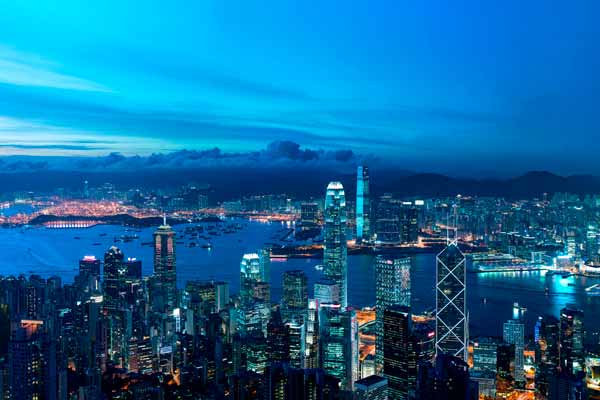Arup Hong Kong, the engineering giant behind numerous large infrastructural projects in the city including the Hong Kong-Shenzhen Western Corridor and the Hong Kong International Airport Passenger Terminal, is celebrating its 40th anniversary. Sylvia Chan speaks with Arup Director Wilfred Lau about the firm’s contribution to the city.

May 18th, 2016
Top image: Hong Kong Harbour
Images courtesy of Arup
Over the past 40 years, Arup Hong Kong has contributed to shaping the city’s urban fabric through projects of different types. These include the 484 metre-high International Commerce Centre, the tallest building in Hong Kong. The engineering firm also has a significant role in building the city’s sophisticated railway network, according to Wilfred Lau, Arup Director. “Our influence on the city’s urban fabric can be seen and felt everywhere,” he says.
Apart from construction, Arup Hong Kong is also engaged in research projects. One of the topics of interest is the Smart Green Resilient framework that involves the planning of next-generation towns. “It stems from our participation in East Asia’s rapid urbanisation for over a decade,” says Lau. Arup Hong Kong observed that critical challenges in city environments were often dealt with in a piecemeal manner, while problems in cities should be considered in a holistic way. “By pushing for solutions that apply systems of thinking across multiple dimensions and at multiple levels, we hope to contribute to making our urban environments more vibrant, diverse and ultimately sustainable,” Lau continues.
Recently, the firm has been appointed to design Hong Kong’s first smart city at Kowloon East, formulating strategies and a business model that will transform the district into a new sustainable CBD. “The project will support economic growth and strengthen the city’s global competitiveness,” says Lau.
Over the past two years, the firm has also been working with the Hong Kong government to examine the development potential of the Northern New Territories. In addition to identifying potential development zones and proposing land uses that will meet the long-term needs of the district, Arup Hong Kong is also defining the next generation of new towns through the project. Lau says, “We adopted a comprehensive approach based on our Smart Green Resilient planning concept.” The new towns will capitalise on infrastructural developments and make better use of the vast area in Northern New Territories to meet housing, social and economic needs. “They [the new towns] will also support preservation of natural resources with high ecological, landscape and environmental value,” says Lau.
Smart cities proposed by Arup Hong Kong do not only concern traditional infrastructural planning but also involve development concepts that will shape future lifestyle and management of cities. For example, digital infrastructure with integrated hardware and software will enable new forms of data processing and sharing, facilitating decision making about city development. A circular economy model for the construction industry will re-conceptualise how products and services are procured, designed, constructed and operated, encouraging recycling of resources. “This will shift the industry towards a more sustainable and resilient future,” Lau says. He adds that in a consultancy study about Hong Kong’s future waste infrastructure, Arup Hong Kong proposed strategies for the city’s waste treatment up to 2041 based on this vision.

The Elements, The Cullinan, International Commerce Centre
Envisioning future cities, Lau anticipates that citizens will have a greater role to play in shaping the environment. “New technologies, and a growing public awareness of environmental issues and the value of built form, will provide city-dwellers with opportunities to increasingly contribute to city form,” Lau says.
He believes that for Hong Kong to remain competitive and maintain its world-class status, the city will need to ensure that its development is sustainable and resilient. He says Hong Kong will need to address several issues in particular, including future land use, spatial arrangement, and integration with the region. Effective and efficient smart infrastructural systems will also need to be developed.

Victoria Harbour Skyline. Photo by Marcel Lam
Local talents are essential for Hong Kong’s future development. As part of Arup’s 40th anniversary, a mentorship programme was launched. Under this programme, 20 Arup engineers will serve as mentors to 20 high school students, exposing them to the planning and engineering profession. “Our past 40 years is a journey that we have shared with the local community. We will continue to shape a better future by assisting in the development of our future leaders,” Lau says.
Arup
arup.com
A searchable and comprehensive guide for specifying leading products and their suppliers
Keep up to date with the latest and greatest from our industry BFF's!

Suitable for applications ranging from schools and retail outlets to computer rooms and X-ray suites, Palettone comes in two varieties and a choice of more than fifty colours.

Channelling the enchanting ambience of the Caffè Greco in Rome, Budapest’s historic Gerbeaud, and Grossi Florentino in Melbourne, Ross Didier’s new collection evokes the designer’s affinity for café experience, while delivering refined seating for contemporary hospitality interiors.

Sub-Zero and Wolf’s prestigious Kitchen Design Contest (KDC) has celebrated the very best in kitchen innovation and aesthetics for three decades now. Recognising premier kitchen design professionals from around the globe, the KDC facilitates innovation, style and functionality that pushes boundaries.

On the eve of 2024, our new editor, Timothy Alouani-Roby, addresses an exciting yet provocative open letter to the Australian architecture community on the opportunities of an era.

After three days of crits, talks and presentations, the full winners of the 2023 World Architecture Festival have been announced.

If you’ve heard Tristram Carfrae speak, then you know he is a pretty inspiring individual. He is a natural leader of people and monumental projects that represent change for good. In this interview he speaks about Arup’s “secret sauce” and the challenge of channelling Gaudi.

Arup is celebrating not only the 50th anniversary of the Sydney Opera House, but also ten years of MADE by the Opera House, the Multidisciplinary Australian Danish Exchange program for which it was one of eight founding partners.
The internet never sleeps! Here's the stuff you might have missed

Milanese artisan Henry Timi celebrates natural materials through strikingly reduced geometric forms, creating a stripped-back vision of interior luxury.

Swiss home appliance designer and manufacturer V-ZUG’s first Sydney studio is a unified expression of the brand’s boutique, sustainable and design-led identity.